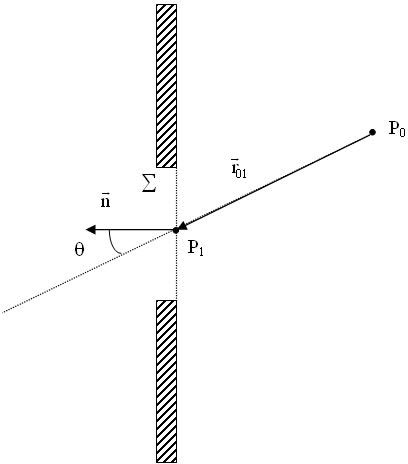
Huygens-Fresnel principle
Let Σ be a diffracting surface (see figure II-1). The Huygens Fresnel principle can be expressed by :
where
 ,
,
 is a unit vector
is a unit vector
 (perpendicular) to Σ ,
(perpendicular) to Σ ,
 ,
,
 , dS is an elementary surface surrounding
, dS is an elementary surface surrounding
 , and U(P1) and U(P0) are the field amplitudes in P1
and P0
.
, and U(P1) and U(P0) are the field amplitudes in P1
and P0
.

Physical meaning of Eq. II-1 :
The field amplitude at a point P0 located after the aperture can be expressed as the superposition of all the diverging spherical waves
 emitted by the secondary sources P1 which constitute the diffracting aperture Σ.
emitted by the secondary sources P1 which constitute the diffracting aperture Σ.
Any secondary source located at P1 has the following properties:
-
Its complex amplitude is proportional to the incident wave amplitude U(P1) .
-
It is weighted by a cosθ term expressing its directivity with respect to the observation point, and by a term dS corresponding the elementary surface participating to the emission.
It is important to notice that this principle is nothing else but a superposition integral expressing the system linearity: an infinity of secondary sources located on the surface Σ are interfering at P0.
We can write:
where h est a weighting function defined by: